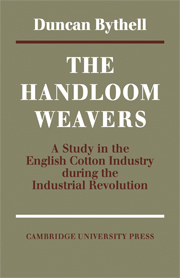Book contents
- Frontmatter
- Contents
- Preface
- Introduction
- Map of the weaving towns and villages of north-east Lancashire in 1821
- 1 Problems and sources
- 2 The organization of the industry
- 3 The labour force
- 4 The coming of the powerloom
- 5 Wages: (I) The piece-rate
- 6 Wages: (II) Earnings and the standard of living
- 7 Public opinion and the handloom weavers
- 8 Organized industrial action among the cotton handloom weavers
- 9 The weavers and radical politics
- 10 The problem of poverty
- 11 Displacement and disappearance
- Appendix 1 Some piece-rate series
- Appendix 2 The piece-rate and the price of food
- Appendix 3 G. H. Wood's estimates of average weekly earnings
- Bibliography
- Index
- Frontmatter
- Contents
- Preface
- Introduction
- Map of the weaving towns and villages of north-east Lancashire in 1821
- 1 Problems and sources
- 2 The organization of the industry
- 3 The labour force
- 4 The coming of the powerloom
- 5 Wages: (I) The piece-rate
- 6 Wages: (II) Earnings and the standard of living
- 7 Public opinion and the handloom weavers
- 8 Organized industrial action among the cotton handloom weavers
- 9 The weavers and radical politics
- 10 The problem of poverty
- 11 Displacement and disappearance
- Appendix 1 Some piece-rate series
- Appendix 2 The piece-rate and the price of food
- Appendix 3 G. H. Wood's estimates of average weekly earnings
- Bibliography
- Index
Summary
The history of the cotton handloom weavers coincides almost exactly with the traditional time limits of the classic English industrial revolution. Before the 1770s, the cotton hand weavers as a body had not existed; by the late 1840s, they had effectively vanished. In three generations, the processes of economic change had first created and then destroyed a new type of labour.
The suffering which accompanied the displacement of these early casualties of the industrial revolution is a matter of common knowledge. But the preliminary process by which the great army of handloom weavers came into existence has been little studied. Yet it is an interesting story. Until the inventions of Hargreaves, Arkwright, and Crompton, the drawbacks inherent in the spinning process had made it extremely difficult to produce cotton yarn strong enough for a warp. Thus although cotton was increasingly used in textiles in the eighteenth century—1·4 million lb of raw cotton were imported in 1700; 2·4 million in 1760; and 6·9 million in 1780—it had mainly been employed in producing mixed goods. The most notable of these were fustians, extensively woven in Lancashire, where cotton weft was crossed with a linen warp.
All-cotton cloth was, therefore, the novel result of Arkwright's water-frame, which made strong warps possible. Indeed, until Arkwright secured a special Act of parliament in 1774, such cloth, hitherto imported from the East Indies, was a prohibited commodity—Englishmen being required by law to wear only those textiles which were made at home.
- Type
- Chapter
- Information
- The Handloom Weavers , pp. 40 - 65Publisher: Cambridge University PressPrint publication year: 1969
- 1
- Cited by



